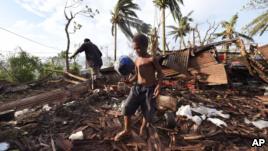
How should the world protect itself from natural disasters and climate change? And who should be paying for this kind of protection? These and other questions are being asked at the United Nations World Conference on Disaster Risk Reduction. The conference is taking place this week in Sendai, Japan. A powerful earthquake and tsunami struck the area four years ago.
A cold wind blows sand along the coast of Sendai. Japanese police officers are searching for evidence in the area. They are examining material washed up on the sand for signs of the March 2011 tsunami. Huge waves struck northern Japan and killed close to 16,000 people. More than 2,500 others are missing and thought to be dead.
United Nations Secretary-General Ban Ki-moon visited Sendai earlier this week. He praised the recovery effort as a model for others. "Sustainability (持续性)starts in Sendai. The disaster risk reduction can be a frontline against the climate change."
Last week, Cyclone(飓风) Pam struck the island nation of Vanuatu. The powerful storm changed its expected path at the last minute. The president of Vanuatu told the UN conference that development in his country had been stopped -- "wiped out" were his exact words.
In late 2004, an earthquake hit the northwestern coast of Indonesia, causing a tsunami across the Indian Ocean. More than 200,000 people were killed. The tsunami led the United Nations to approve a 10-year program for reducing disaster risk. It is called the Hyogo Framework for Action. That 10-year period is ending this week. Delegates to the conference are trying to reach a new agreement.
Delegates mostly agree that natural disasters are causing bigger problems. But they are having a difficult time deciding how to reduce the risks. The severe damage caused by Cyclone Pam in Vanuatu is pressuring them to reach an agreement on how the world should deal with natural disasters.
本时文内容由奇速英语国际教育研究院原创编写,禁止复制和任何商业用途,版权所有,侵权必究!
1.What’s the purpose of the conference?
A To protect our nature
B To deal with natural disasters
C To stop climate change
D To answer some questions
解析:选B。B 主旨大意题。根据首末段可知,此会是为了解决怎样应对自然灾害的问题,故选B。
2.How many deaths were caused by the 2011 tsunami in Sendai except the missing ones?
A more than 16,000
B less than 16,000
C more than18,500
D less than18,500
解析:选B。B 细节理解题。根据第2段...killed close to 16,000 people, 可知答案,故选B。
3.How is the recovery work in Sendai?
A It is well carried on.
B It goes on difficultly.
C It should be started earlier.
D It changes quite fast.
解析:选A。A 推理判断题。由第3段...He praised the recovery effort as a model for others.可知当地的灾后重建工作开展的不错,故选A。
4.The Hyogo Framework for Action was passed because of _____.
A the World Conference delegates
B Cyclone Pam in Vanuatu
C Secretary-General Ban Ki-moon
D The Indonesian tsunami
解析:选D。D 细节理解题。根据第5段 ...The tsunami led the United Nations to approve a 10-year program... , 可知答案,故选D。
5.The underlined word pressuring in the last paragraph probably means _______.
A pressing
B stressing
C forcing
D causing
解析:选C。C 词义猜测题。由画线单词前一句看出代表们做决定很困难,应该是新发生的飓风迫使他们达成新的协议,故选C。